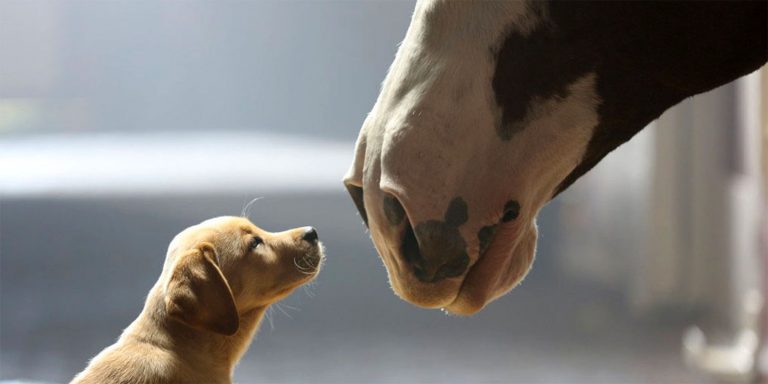A look at what a flood of emotionally manipulative Super Bowl ads means in the bigger picture.
Are Super Bowl commercials a snapshot of a moment in time in American society? The loud, brazen catchphrase commercials of the ’90s fit so well with the garishness of the era. The poorly thought out dot com commercials of the early 2000s perfectly fit the poorly thought out businesses they promoted. The race to the milquetoast middle of the late 2000s and early 2010s showed marketers’ increased fear to step outside of the safety zone in a time when anything even remotely edgy births a loud, quick backlash followed by a requisite apology.
Now we’re here, in 2015. And if the Super Bowl ads are reflective of anything, it’s that brands have realized the fastest way into our wallets is through our hearts.
ELEVEN (how fitting for this website) of the top 15 commercials from this year’s Super Bowl on USA Today‘s annual Ad Meter are sentimental, emotional or serious ads: Budweiser’s lost dog, Always maxi pads reclaiming the phrase “Like a Girl,” Microsoft’s child with prosthetic legs, Dodge’s old people sharing wisdom, Toyota’s sweetheart dad, Coca-Cola’s anti-bullying-via-Coke message, Nissan’s sweetheart dad, McDonald’s letting you pay with a hug, Dove’s sweetheart dad, the anti-domestic violence ad and Jeep’s tribute to American landscapes.
So how did we get here?
Let’s go back about a year or two. When Upworthy invaded Facebook, it used a new and brilliantly insidious formula. First-person headlines on emotionally evocative stories. “I Saw This Disabled Veteran on the Street Next to an Autistic Rattlesnake, What He Did Next Changed My Life Forever.” And it worked — it worked big. Upworthy’s traffic skyrocketed and, along with it, their ad revenue did as well. (As did the ad revenue of a never-ending stream of Upworthy clones.)
Upworthy openly admits their number one priority is the headline, not the story. They have a team writing at least a dozen possible headlines for each story, trying to determine which will intice the maximum number of clicks. The emotionally evocative story isn’t the endgame — getting you to click a headline on Facebook that takes you to that emotionally evocative story is.
They cracked the code. Your emotions are for sale. And now the big guns have noticed.
The cost of a Super Bowl ad is widely publicized: $4.5 million for 30 seconds! Crazy money!
It’s not crazy money. That’s the cost of a big client dinner and like three office chairs to virtually every company that advertised during the Super Bowl. It’s also not the real cost. Tens of millions of dollars — maybe even more — worth of hours, research and production go into each one.
Every ad during the Super Bowl (with the exception of perhaps the crowdsourced Doritos ads) is the product of dozens, if not hundreds or thousands, of brains. Ad agency brains. Marketing department brains. Even super high paid executive level brains. Every commercial that runs during the Super Bowl is masterfully engineered, tested and tweaked to serve a specific purpose.
And this year, at least a dozen companies determined that sentimental was the best advertising approach to take.
As much as I’d like to blame it on the Upworthification of media, that doesn’t tell the whole story — because these ads are also just us reaping what we’ve sowed.
First, it’s hard to be funny and safe — which is basically required in the era of the Twitter outrage machine. Look at comedy today. The edgy stuff hides in the fringes of cable, in places like FXX. Meanwhile, mainstream network TV sitcoms are mostly dead on arrival. Safe comedy is hard — and companies have been getting blasted for years for the lame, flaccid attempts at comedy in Super Bowl commercials. So why bother? Why not go sentimental? Those commercials are almost criticism-proof — can I really sit here and blast ads about female empowerment, life-changing medical technology, amazing fathers, or the beauty of America and its people? And looking at how they fared on USA Today, they’re also wildly popular.
And second, emotions work. The generations in the “money” demographic now are the first two generations that grew up in an environment where emotions were encouraged and applauded. So it’s quite natural that tapping into emotions moves the needle. It’s hard to understand why it took this long for companies to figure that out.
And that’s really the problem. There are plenty of stories in those Super Bowl commercials that deserved to be told — and that’s the best venue to tell them to maximize their exposure. The emotions they brought out were genuine — but tainted. It’s the co-opting of emotions for the sake of brand equity. It’s emotional manipulation at $9 million-a-minute on the one day a year when advertising doesn’t interrupt the story, it is the story. It’s your emotions commodified and exploited. It feels awfully bad to be that easily manipulated.
But wow, did it work. These ads dominated in popularity, they’re dominating the online conversation and every company that ran one is currently toasting to their brilliant decision. Fittingly, the commercial that ranked most popular was the Budweiser lost dog one, which didn’t even have a message about gender or dads or old people or America or social causes or anything — it was just raw emotional manipulation through adorable animals. It would be shocking if next year, the ratio of funny commercials to sentimental ones doesn’t skew even more toward the latter. Hook, line, sinker.
So if Super Bowl ads really are a snapshot of a moment in time, the mid-2010s are a time of overt sentimentality that’s somewhat disingenuous, extremely viral and brimming with navel-gazing maudlin satisfaction.
I hope one day, those deserving stories will be told elsewhere, just as loudly, so we can get to commercials with monkeys hitting buffoon dads in the nuts soon. Somehow, that feels less dirty.
